El Banco de Hidalgo
The concession for a bank of issue in Hidalgo was granted to Maquivar y Compañía, Carlos Francisco de Landero, Manuel Araoz and J. Octavio Fernández on 28 February 1902. The Banco de Hidalgo opened for business on 1 November 1902 with a capital of 500,000 pesos.
The first council of administration was composed of Carlos Francisco de Landero, Agustín Inurritegui, James Bennetts, José Calero, Rafael M. de Arozarena, Raul Prieto and Francisco de Landero y Pascuel, while the advisory board in Mexico City consisted of Joaquín D. Casasús, Manuel Araoz, Hugo Scherer, Jr., José González Misa, Fernando Pimentel y Fagoaga and J. Octavio Fernández. The general manager was Ramón Castañeda y Palomar and the cashier Juan CarrionThe Mexican Herald, vol. XV, no. 27, 1 June 1902. For 1906 the council of administration consisted of Carlos Francisco de Landero, president: Richard Honey, vice president; Agustín Inurritegui, Jaime Bennetts, L. Marguevar, Richard Honey, Jr., and Fernando P. Tagle, with the respective substitutes. The consulting board, resident in Mexico, consisted of Joaquin Equia, J. B. Ricardo Gallardo, Porfirio Diaz, Jr., Thomas P. Honey, H. E. Brook and José V. Burgos. The interventor was Ramon Prida. manager Ramon Castañeda y Palomar, the accountant was G. González and cashier, Carlos J. Darve (The Mexican Herald, 4 April 1906).
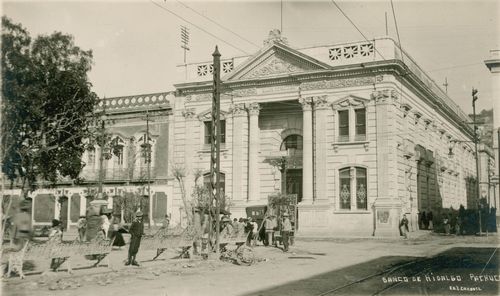
The bank’s main offices, on the corner of calle Plaza Independencia and calle Nicolás Bravo, were designed in a neoclassical style by the architect Ernesto Fuchs and constructed in 1905.
The bank established a branch in Tulancingo on 15 December 1906 with Javier Gómez as gerenteFidel Gómez was contador and Miguel F. Pérez was cajero. Martín García was president of the Junta Local, Gorgonio de la Concha segundo vocal, and Gabriel San Vicente tercer vocal.
The Comisión Reguladora declared the bank's concession forfeited on 16 November 1915.
Under Obregón decree of 31 January 1921 the bank was placed into Class B (for banks whose assets and liabilities were about equal and which were given a short time in which to obtain the necessary funds to resume) and allowed to resume all customary operations except the issue of bank notes.
American Bank Note Company print runs
The American Bank Note Company produced the following notes. The company engraved the following special vignettes: Juan C. Doria, first governor of Hidalgo (C253)Juan C. Doria was born in Real de Borbón (present - day Villagran), Tamaulipas. At the age of nine he was sent to Linares, Nuevo León, to study. He specialized in philosophy, and later, he studied law in Monterrey and Mexico City. He graduated as a lawyer during the days of the French intervention. He was appointed secretary to the Governor of Nuevo León. In 1865, as political and military chieftain of Linares, he formed a cavalry group and joined forces with Mariano Escobedo. He and Hipolito Charles formed the “Cuerpo de Cazadores de Galeana” (Galeana’ Hunters). When Escobedo occupied Monterrey and became State governor, he served as his secretary. He accompanied him in the siege of Querétaro where he fought heroically. When the Republic triumphed, he occupied an important post in the Department of War. Later, he was appointed Governor of the State of Hidalgo. for the $10 and $100 notes, Pedro Romero de TerrenosPedro Romero de Terreros was born in Cortegana, Spain, on 28 June 1710. Several members of his extended family had previously emigrated to the New World and operated successful businesses there, and about 1730, Romero de Terreros journeyed to Mexico and joined his uncle in Querétaro. Romero de Terreros showed an affinity for making money and soon brought his uncle’s businesses back into profitability. In 1741, he began to invest in the Pachuca-Mineral del Monte silver mines, along with his business partner Jose Alejandro Bustamante.
As his personal wealth rose, so did his social status. He served as alcalde of Querétaro, and in 1752 was given an honorary knighthood in the Order of Calatrava. He lobbied very hard to be elevated to the nobility and in 1768 was named the first Count of Regla (Conde de Santa María de Regla).
In the 1740s Romero de Terreros became a patron of the Franciscan order in Mexico. From 1745 through to 1781 he gave 41,933 pesos to the Franciscan seminary College of San Fernando de México and another 91,023 pesos to the seminary College of Santa Cruz de Querétaro, as well as 100,000 pesos for the monastery in Pachuca. He also funded missionaries in Spanish Texas, though his mission was destroyed by Indians. Besides his support for the Catholic Church in Mexico, Romero de Terreros also gave funds to civil authorities and funded a battleship for the Spanish navy.
Between 1774 and 1777, he established the Monte de Piedad, a charitable institution and pawnshop, as an attempt to provide interest-free or low-interest loans to the poor. for the $50, the monument to Hidalgo (C 845) for the $5, $20 and $100, and a view of Pachuca (C 839) for all the backs.
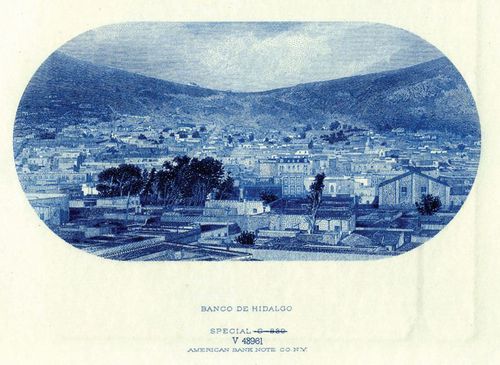
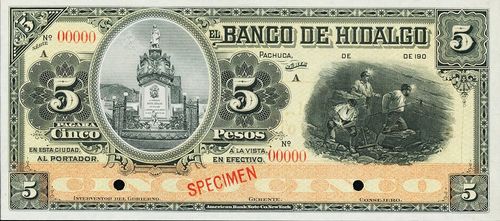
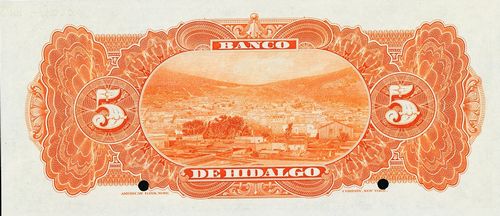
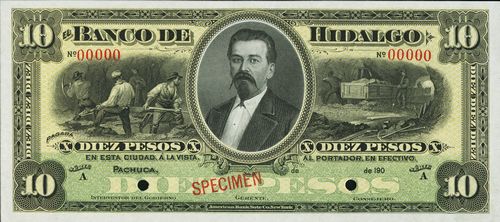
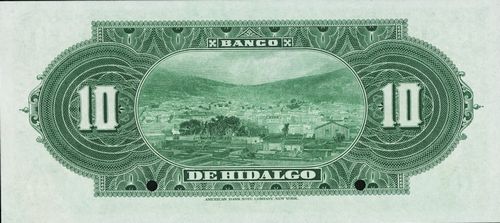
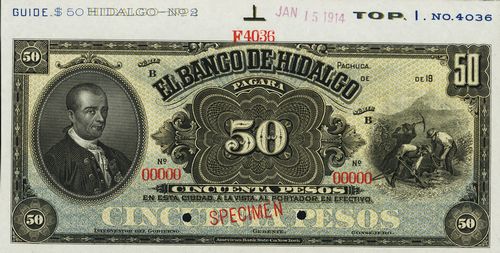
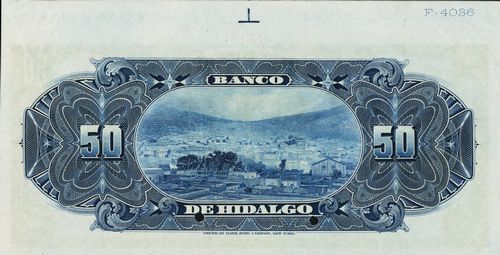
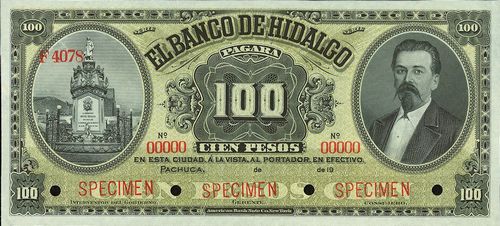
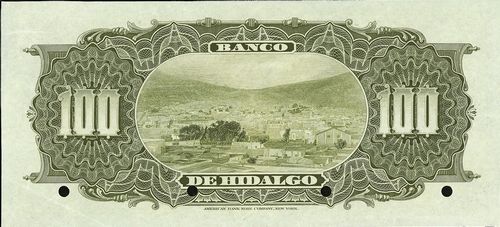
| Date | Value | Number | Series | from | to |
| May 1902 | $5 | 50,000 | A | 1 | 50000 |
| $10 | 25,000 | A | 1 | 25000 | |
| $20 | 15,000 | A | 1 | 15000 | |
| $50 | 10,000 | A | 1 | 10000 | |
| $100 | 2,000 | A | 1 | 2000 |
On 1 June 1902 it was reported that the notes were being lithographed by the New York Bank Note company (sic) and would be ready for delivery in Pachuca within two months, so that the bank would be prepared to commence business by 1 AugustThe Mexican Herald, vol. XV, no. 27, 1 June 1902.
On 8 August 1905 the bank asked for a quotation for 500 new $500 notes, with a portrait of Hidalgo on the face and the view of Pachuca, as used on the earlier notes, on the bankABNC, folder 193, Banco de Hidalgo (1905-1931). There is no correspondence in the ABNC files on why the vignette on the back was changed to a special one of the bank building (C 1013).
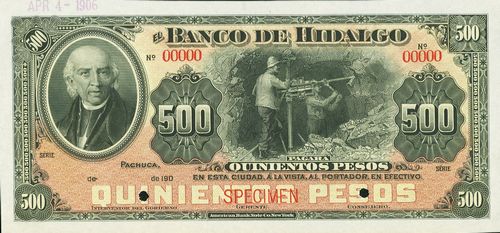
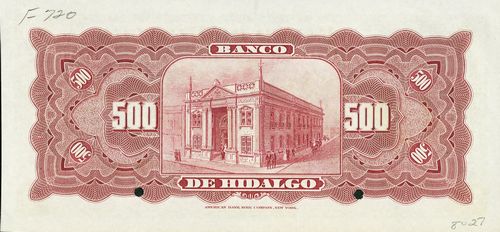
| Date | Value | Number | Series | from | to |
| November 1905 | $500 | 500 | B | 1 | 500 |
On 13 July 1910 the bank asked for a quotation for a new issue of 25,000 $5 notes. On 8 August the bank accepted the quotation (which Blackmore had in fact taken the liberty of increasing) and at the same time ordered 2,000 $100 notes. The notes were to be shipped, via Laredo, to the bank’s parent company, the Banco Internacional é Hipotecario de México, in Mexico City.
| Date | Value | Number | Series | from | to |
| July 1910 | $5 | 25,000 | B | 50001 | 75000 |
On 8 August the bank ordered another 2,000 $100 notes.
| Date | Value | Number | Series | from | to |
| August 1910 | $100 | 2,000 | B | 2001 | 4000 |
Thus, on 1 October the ABNC forwarded to the Banco Internacional é Hipotecario de México, in Mexico City, a box containing these 25,000 $5 and 2,000 $100 notesABNC, folder 160, Banco Internacional é Hipotecario (1904-1933).
On 16 January 1914 the bank ordered a new issue of $5, $10, $20, $50 and $100 notes. Following Huerta's modification to the Ley general de Instituciones de Crêdito to allow the issue of $1 and $2 notes, the bank added 500,000 $1 notes. Its specification for this new denomination was “The one peso note to be about the same size and style as those issued by the Banco Nacional de México. The text is to be the same as appears in their other denominations, the date line to read Pachuca---------------. On the Face they desire a vignette of some mining scene, in the center. The design and colour of the face are to be left to your own good judgement. No models are required. Back. Same style and colour as the back of the 50 peso Chile note, substituting the vignette which appears on the Chile note by the vignette of Hidalgo which appears on the face of the 500 peso notes issued by this same Bank. The one peso notes to be numbered from number one onwards and Serie “A”ABNC, folder 193, Banco de Hidalgo (1905-1931).
The bank also asked the ABNC to use a heavier paper than previously used.
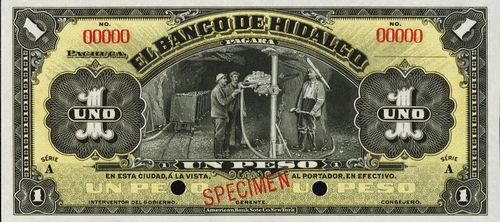
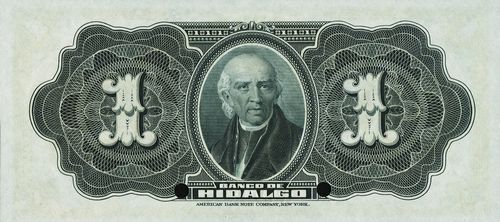
| Date | Value | Number | Series | from | to |
| January 1914 | $1 | 500,000 | A | 1 | 500000 |
| $5 | 50.000 | C | 75001 | 125000 | |
| $10 | 25,000 | B | 25001 | 50000 | |
| $20 | 20,000 | B | 15001 | 35000 | |
| $50 | 10,000 | B | 10001 | 20000 | |
| $100 | 2,000 | C | 4001 | 6000 |
On 3 February 1914 the bank increased the order of $100 notes from 2,000 to 5,000, as it desperately needed these larger denomination notes. However, by this time the work on the original order had been finished and for this reason the ABNC was unable to print the increase at the same time but had to prepare once again new lithographic transfers and make ready the printing presses. This naturally took some time so delayed shipment.
| Date | Value | Number | Series | from | to |
| February 1914 | $100 | 3,000 | C | 6001 | 9000 |
Although the ABNC had promised to ship the original 2,000 $100 on 11 February, it missed this date (because 12 February was a national holiday for Lincoln’s birthday, the Ward Line Steamer left earlier on 11 February, and this sudden advancement upset the ABNC’s schedule). So, on 19 February the ABNC consigned to the Banco Internacional é Hipotecario de Mexico, via the S, S. “Monterey”, a box containing 5,000 $50 (B 10001-15000) and 2,000 $100 (C 4001-6000).
The next week, on 26 February, it shipped, on the S. S. “Morro Castle”, 4,000 $10 (B 25001-29000), 5,000 $50 (B 15001-20000) and 1,000 $100 (C 6001-7000).
On 2 March the ABNC's E. N. Gibbs sent J. V. Burgos, the sub-manager of the Banco Internacional é Hipotecario de Mexico, face and back proofs of the $1 note. He wrote, “As I promised you, I have personally looked after this order and I sincerely hope that you will find these engravings acceptable. The back especially I think looks very handsome and is along the lines of the Banco de Chile note that you saw in our specimen book and liked so much. It has taken us a little longer than I anticipated to prepare these engravings and I am a little afraid that we will be unable to ship 50,000 to you on the 12th of this month. We are doing all in our power and you can be sure that we will ship all that we possibly can on that date.”
The ABNC then made regular weekly consignments. On 5 March the ABNC shipped, per the S.S. “Esperanza”, 21,000 $10 (B 29001-509000) and 1,000 $100 (C 7001-8000). On 12 March it shipped, per the steamer “Mexico”, 30,000 $1, (A 000001-030000). 25,000 $5 (C 75001-100000) and 1,000 $100 (C 8001-9000). On 19 March, it shipped, per the S. S. “Monterey”, 70,000 $1 (A 030001-100000), 25,000 $5 (C 100001-125000) and 10,000 $50 (B 15001-25000). On 26 March it shipped, via the steamer “Morro Castle” 50,000 $1 (A 100001-150000) and 10,000 $20 (B 25001-35000). On 2 April it shipped, via the “Esperanza”, 100,00 $1 (A 150001-250000). On 9 April it shipped, per the S.S. “Mexico”, another 100,000 $1 (A 250001-350000). Finally, on 15 April, it completed the order, forwarding, via the S.S. Monterey”, 150,000 $1 notes (A 350001-500000).
On 18 August 1931 the ABNC cancelled the plates that it had in its plate vaultThese were:
4 – 10 on 1 peso face plates Nos. A1 to A4 made on order No. F 4050
4 – 10 on 1 peso back plates Nos. A1 to A4 made on order No. F 4050
1 – 1 on 1 peso tints Nos. 1 &2 made on order No. F 4050
1 – 6 on 5 pesos face plate #2 made on order No. F 4033
1 – 6 on 5 pesos back plate made on order No. F 61
1 – 1 on 5 pesos tints Nos. 1 &2 made on order No. F 61
1 – 4 on 10 pesos face plate made on order No. F 61
1 – 4 on 10 pesos back plate made on order No. F 61
1 – 1 on 10 pesos tints Nos. 1 &2 made on order No. F 61
1 – 4 on 20 pesos face plate made on order No. F 61
1 – 4 on 20 pesos back plate No. 2 made on order No. F 4035
1 – 1 on 20 pesos tints Nos. 1 &2 made on order No. F 61
1 – 2 on 50 pesos face plate made on order No. F 61
1 – 2 on 50 pesos back plate No. 2 made on order No. F 4036
1 – 1 on 50 pesos tints Nos. 1 &2 made on order No. F 61
1 – 1 on 100 pesos face plate made on order No. F 61
1 – 1 on 100 pesos back plate made on order No. F 61
1 – 1 on 100 pesos tints Nos. 1 &2 made on order No. F 61
1 – 1 on 500 pesos face plate made on order No. F 120
1 – 1 on 500 pesos back plate made on order No. F 120
1 – 1 on 500 pesos tints Nos. 1 &2 made on order No. F 720.
